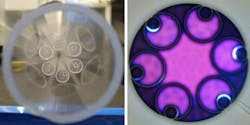Hollow-core fiber-optic cable delivers 10-Gbit DWDM transmission over 10 km links
By JOHN WALLACE -- Fiber-optic cabling maker Lumenisity Limited (Romsey, UK) has unveiled a new hollow-core fiber cable, called CoreSmart, for dense wavelength-division multplexing (DWDM) operation over links in excess of 10 km.
In hollow-core fibers, light propagates in an air-containing core formed by microscopic capillaries. They have a big advantage over conventional solid glass fibers: data travels 50% faster in hollow-core fiber, as the light propagates in air. Propagation in air offers the potential for higher data capacity and extended reach due to the 1000X reduction in power-induced nonlinear optical effects that occur in glass.
A key challenge has been both the design and manufacturing processes -- in particular, making the fibers and developing the cable and processes for seamless in-field installation in existing and "green-field" networks. Lumenisity says that, in collaboration with the University of Southampton, it has solved many of these challenges to create rugged cables designed for deployment in meaningful lengths for the metro network.
Lumenisity’s CoreSmart hollow-core cable uses nested antiresonant nodeless fiber (NANF) technology, which the company has patented. Lumenisity says that another type of hollow-core design, photonic bandgap fiber (PBGF), is inherently multimoded and requires complex solutions to reduce the impact of parasitic modes on the hollow-core performance, whereas Lumenisity’s new fiber is robustly single-moded, providing uninterrupted simultaneous single-mode transmission at 1310 nm, and over the C and L bands and beyond.
The NANF technology offers the promise of realizing loss values at, or better than, conventional solid silica core fibers, says the company. CoreSmart hollow-core cable currently being deployed has losses of about 2 dB/km over a wide temperature range, which Lumenisity says is the lowest loss deployable hollow-core cable commercially available to date.
The CoreSmart cable technology is designed to be backward compatible with existing networks and systems equipment; it can be spliced directly in the field by accredited installers with commercially available splicers, using Lumenisty’s (proprietary patent-pending) hollow-core-to-conventional-fiber adapter technology. The splices allow 10 concatenated segments to be used together and still meet carrier grade telecommunication error rate requirements.
The cable technology has been "ruggedly tested and proven in challenging environments," says Lumenisity. The company, with its customers and partners, has deployed multiple cables globally that are carrying live production traffic in the field, with some carrying traffic for more than three years.
The new cable just unveiled by Lumenisity extends this capability to 10 km links with full broadband DWDM capability at 10 Gbit per channel. Segment lengths vary with application. Cables are being evaluated for higher data rates over the coming months. For more info, contact [email protected].
JOHN WALLACE is Senior Editor of CI&M's sister publication, Laser Focus World.
